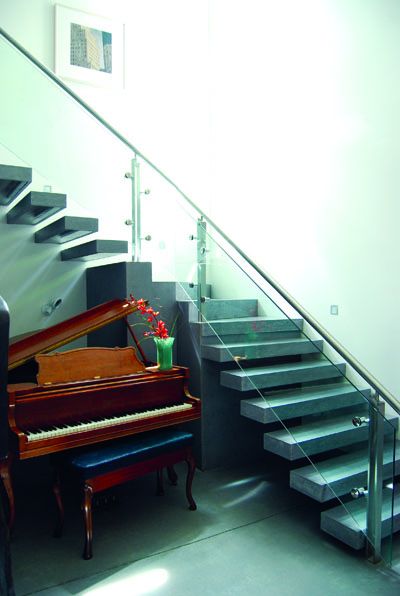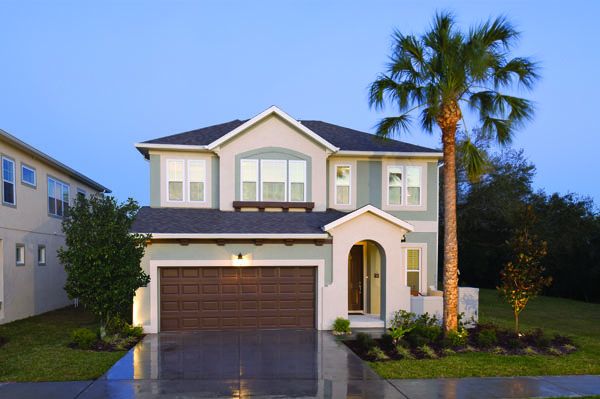
Just about everything is concrete in this home by Rokop General Contractors and Concrete-N-Counters.
Green is Growing
Green building has pushed beyond the high-end, custom-home market and into production building, remodeling and home products.
It’s a trend that’s reshaping how we live and do business, according to home building professionals who spoke at the National Association of Home Builders’ (NAHB) International Builders’ Show, held in Las Vegas in January.
Construction industry professionals and manufacturers are beginning to “green their processes” and incorporate more energy-, water- and resource-efficient features.
Builders and remodelers also are doing a better job of explaining the value of green upgrades such as extra insulation and right-sized heating and cooling systems—and consumers are getting it.
That’s why, despite the housing market’s recent downturn, green building showed growth, according to research by McGraw-Hill Construction. The prediction? Green building, which is today a $96 billion market, will be a $140 billion market in five years.
In 2009, more than 700 homes, subdivisions and remodeling projects received National Green Building Certification administered by the NAHB Research Center. That’s a 600 percent jump over 2008. Concurrently, the Florida Green Building Coalition has certified more than 2,100 homes and more than 75,000 acres of land development.
“In Tampa">Tampa Bay, green building is definitely growing in popularity,” says Lisa Potvin of Concrete-N-Counters, a concrete showroom and manufacturer in Lutz. “People are learning about green products and it’s intriguing them more and more.”
Concrete-N-Counters supplied the concrete countertops, floors, sinks and other elements used in the greener-than-green Treasure Island house that won St. Petersburg contractor Jeffery Wolf two prestigious Aurora awards for green construction and energy-efficiency.
Tampa">Tampa Bay builders and remodelers say energy efficiency will continue to propel the green movement as consumers realize the cost-saving benefits and as they take advantage of government incentives and rebates.
We asked local building industry professionals what green trends we can expect to see in 2010. Here’s what they predict:
> Building smaller homes. Homebuyers have become more conservative in their spending and banks are tightening credit, so we can expect to see new homes that are more modestly sized, more affordable and more energy-efficient.
“The age of the mansion is gone except for the extremely wealthy,” says Tampa">Tampa Bay remodeler Jon Greaves of Greaves Construction. “People won’t be able to get those big loans anymore and are staying within their means. Large homes cost more to buy—and to heat and cool.”
> Remodeling existing homes. Look for the focus of the green building movement to switch from new homes to greening existing homes. Why? Several reasons: More home-owners will stay put because they can’t afford to move. Consequently, they’ll choose to spruce up their homes—especially kitchens and baths, Potvin says.
Tampa">Tampa remodeler Cathy Byrd of Innovative Restorations says the majority of existing homes in the Tampa">Tampa Bay area are energy-wasters, but they could perform better with added insulation, new windows and a more efficient heating and cooling system.
She says these improvements have always made sense because they pay for themselves over time with reduced energy bills, but now, with the tax credits, homeowners have even more incentive to go green.
Tampa">Tampa remodeler Jeff Ulbrich of Dream Renovations predicts there will be more interest in features such as tankless water heaters, which provide hot water only as it’s needed, and hot water recirculation systems, which conserve water and can save energy.
These systems use a pump to pull hot water quickly from a water heater while simultaneously sending cooled-off water from the hot water lines back to the water heater to be reheated.
Low-e windows are also gaining in popularity, Ulbrich says. Low-emissive, or low-e, coating blocks much of the sun’s heat while still allowing in the light.
> Using renewable energy. As energy costs continue to rise, homeowners will pay more attention to energy-saving measures of all kinds, Byrd says.
Energy Star-rated appliances, lighting and fixtures are becoming al- most standard. But solar and wind pow- er and net-zero energy houses will be a hot topic in 2010 and beyond too.
Net-zero energy homes generate more energy than they use, on average, by combining energy efficiency with on-site energy generation such as solar power.
Achieving the goal of net-zero energy use isn’t yet affordable for the average homeowner, Byrd notes. But there are a few zero-energy projects already in the works or completed, including the Treasure Island home built by Wolf.
Federal tax credits will spur some homeowners to install state-of-the-art energy-efficient systems including solar water heaters, solar panels and small wind energy systems.
> Conserving water. We can expect to see more homes with water-conserving features, rainwater recovery systems and eco-friendly landscaping products. People are becoming more aware of the crisis in the fresh water supply, Greaves says.
Updated building codes reflect that concern. New and remodeled homes are getting greener with products such as low-flow plumbing fixtures and dual-flush toilets.
“Everybody is interested in saving energy to save money,” Ulbrich says. “But with conserving water, there’s more focus on conservation of a resource than saving money. The dollar savings aren’t that much on water. But people visually see the impact of high water consumption. They see the lakes are down.”
Green Building Update
Concrete can be a durable, versatile and aesthetically pleasing building material that’s especially suitable for homes in hurricane-prone areas.
For example, a Tampa">Tampa Bay home built in 2009 is made of masonry block filled with solid concrete. Columns, balconies and tie beams are also poured concrete while concrete tiles are used on the roof.
In addition, Rokop General Contractors worked with Concrete-N-Counters in Lutz to create an eco-friendly, modern interior with precast concrete countertops, sinks and stair treads and stained concrete floors and patios. Also made of concrete is the bathroom shower and a decorative textured wall.
Concrete is a big trend right now, especially for floors and countertops, says Lisa Potvin of Concrete-N-Counters. “We’ve had our busiest year ever,” she says. “We’ve had to turn away work.”
Floors can be stained, scored and polished to achieve just about any look a homeowner wants, she adds. Countertops can have integrated sinks of any size and shape. And both can be personalized by embedding crushed wine bottles, shells or other personal mementos.
Ashton Woods Homes knows that energy-efficiency is a top concern for homeowners today. Check out the company’s new four-bedroom, single-family model home at Citrus Park Place in northwest Tampa" target="_blank">Tampa" target="_blank">Hillsborough County. ?
This 2,056-square-foot home showcases Power House Green energy- saving features, which meet Environments for Living performance standards as well as the EPA’s Energy Star program standards for new construction.
The program uses building science techniques to help reduce energy loss and establishes requirements for tight construction, improved thermal systems, right-sized heating and cooling systems, fresh air ventilation, balanced air pressure, internal moisture management and combustion safety.
 Think concrete can’t be pretty? Then you haven’t seen this home by Rokop General Contractors and Concrete-N-Counters, in which just about everything is concrete, including the precast stair treads.
Think concrete can’t be pretty? Then you haven’t seen this home by Rokop General Contractors and Concrete-N-Counters, in which just about everything is concrete, including the precast stair treads.

This home by Ashton Woods showcases Power House Green energy-saving features.
